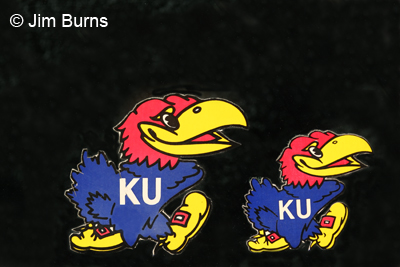
From earliest recorded history we have named gods, implements of war, our children, and our sports mascots after the birds we admire and their physical characteristics we envy. Beauty. Grace. Power. Flight. And just as some avian species combine several of these traits, many of our mythical birds combine the attributes of several species. Thus the Kansas Jayhawk is a fusion of the best (or worst, depending on territorial loyalty and your tolerance for anthropomorphism) of two common Midwestern birds, the Blue Jay and the American Kestrel or Sparrowhawk as the latter was known in the common vernacular of the 1840s when the myth of the Jayhawk took wing.
The Blue Jay, a robin sized bird of Eastern forests, is a raucous, quarrelsome bird known to mimic the calls of hawks, rob the nests of other species, and eat their young, but it can melt silently into the woods and is capable of great stealth. Rarely recorded west of the plains, it is in the same family as the Steller's Jay and the Mexican Jay, well known to Arizona birders.
For our American Kestrel the old colloquial name, Sparrowhawk, is something of a misnomer. The kestrel is a small falcon which preys primarily on large insects and small rodents but may take small birds when opportunity presents. Like all falcons, kestrels are swift of wing, but unlike most in the family they are often seen "kiting"-- hovering with rapid wingbeats in one spot--over fields and farmland watching for prey, which is then captured in the talons at the bottom of a rapid stoop.
The term "Jayhawkers" originated somewhere along the Missouri/Kansas border in the late 1840s. arising from armed guerilla skirmishes between pro-slavery (Missouri) and free-state (Kansas) settlers. Though in its original context "Jayhawkers" referred to bands of thugs on both sides who struck viciously and without warming, during the Civil War it was the Seventh Kansas Cavalry under Charles Jennison that came to be widely known as the Jayhawkers.
In these post-modern times when war (large wars at least) has been replaced by athletic endeavor, the physical prowess of our mythical mascots continues to reflect the quest for power and glory which resides deep within our DNA. Today they celebrate ancient exigencies--the fight for survival, the flight for freedom. And so, to all Mizzou tigers out there, we give you "Rock Chalk, Jayhawk."